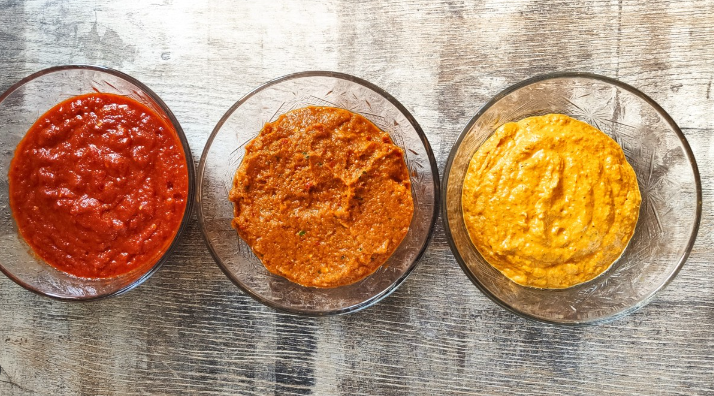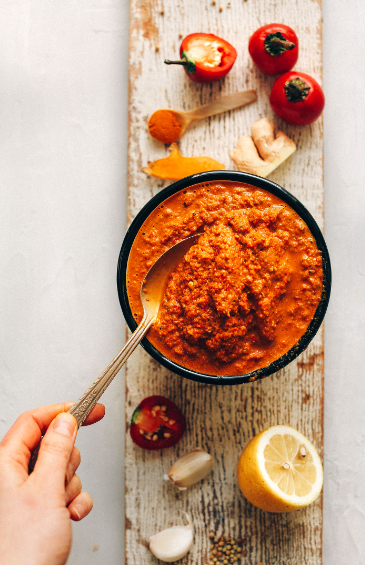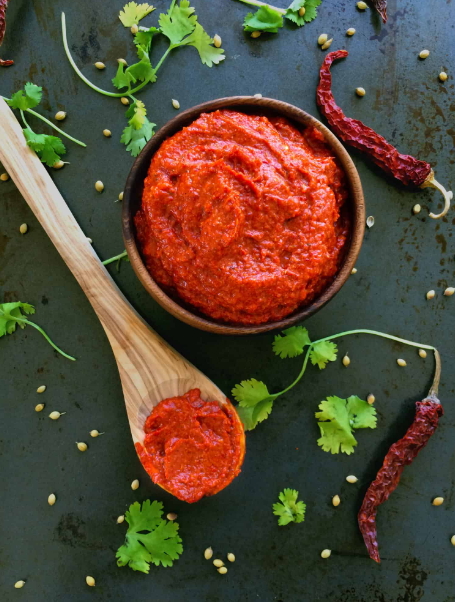Spices Pastes Uses Benefits & Nutritional
Asafoetida Paste:
- Nutrition Value:
- Asafoetida (also known as hing) is the dried sap obtained from the roots of Ferula plants. It’s commonly used in Indian cuisine.
- While research is limited, asafoetida has been found to be a good source of antioxidants. These compounds protect your cells against damage caused by unstable molecules called free radicals.
- Specifically, asafoetida contains high amounts of phenolic compounds, such as tannins and flavonoids, which have potent antioxidant effects.
- However, due to its strong odor, it’s sometimes referred to as “stinking gum”. When cooked, its flavor becomes more palatable, similar to leeks, garlic, and meat.
- Potential Benefits:
- Digestion Aid: Asafoetida is commonly used to aid digestion. It increases the activity of digestive enzymes and may enhance bile release from the liver, which is essential for digesting fat.
- Anti-Inflammatory Properties: While more research is needed, test-tube and animal studies suggest that asafoetida exhibits anti-inflammatoryand antioxidant activity.
- Indigestion Relief: In a study, adults with moderate to severe indigestion reported significant improvements in bloating, digestion, and overall quality of life after taking asafoetida capsules.
- Traditional Uses: In Ayurvedic medicine, hing is used to treat bronchitis, kidney stones, and gas. During the Middle Ages, people even wore dried gum around their necks to ward off infection and disease.
- Culinary Uses:
- Asafoetida is used in small amounts in cooking, so its potential health benefits may not fully apply to culinary use.
- In Indian cuisine, it adds flavor to dishes like lentils, curries, and pickles.
- Nutrient Content:
- Consuming 100 grams of asafoetida provides:
- Iron: 39 mg
- Calcium: 690 mg
- Carbohydrates: 68 g
- Dietary Fiber: 4 g
- Protein: 4 g
- Phosphorus: 50 mg
- Total Fat: 1 g2.
- Consuming 100 grams of asafoetida provides:
In summary, while Asafoetida has potential health benefits, more research is needed to fully understand its effects. Enjoy it in your favorite dishes, and embrace its unique flavor!
Bay Leaf Paste:
- Nutrition Value:
- Bay leaf (also known as laurel) is a spice commonly used to flavor soups and meat dishes for its light, herbal flavor.
- It is rich in essential nutrients and antioxidants.
- Here’s the nutritional content of bay leaf:
- Vitamin A: Supports a healthy immune system.
- Vitamin B6: Essential for various bodily functions.
- Vitamin C: Boosts immunity and aids wound healing.
- Calcium: Important for bone health.
- Iron: Essential for oxygen transport in the blood.
- Manganese: Supports metabolism and bone health.
- A crumbled tablespoon of bay leaf contains approximately:
- Calories: 5.5
- Protein: 0.1 g
- Fat: 0.1 g
- Carbohydrates: 1.3 g
- Fiber: 0.5 g
- Health Benefits:
- Immune System Health: Bay leaf is a good source of vitamins A, B6, and C, which support a healthy immune system.
- Digestive Aid: Bay leaf tea can ease upset stomach and relieve sinus pressure.
- Potential Diabetes Benefits: Some studies suggest that bay leaf may help lower blood sugar levels, but more research is needed.
- Anti-Inflammatory Properties: Bay leaf contains compounds that may reduce inflammation.
- Heart Health: Bay leaves contribute to overall well-being and heart health.
- Respiratory Health: Bay leaf paste can alleviate respiratory issues.
Joint Health: Bay leaf paste, when combined with castor leaves, may help reduce pain from sprains and joint problems




- How to Make Bay Leaf Paste:
- Ingredients:
- A few handfuls of fresh bay leaves (avoid tough leaves like rosemary)
- A small amount of olive oil
- Instructions:
- Separate the leaves from the stems.
- Place the leaves in a food processor and pulse until finely chopped.
- Gradually add a drizzle of olive oil while continuing to process until the texture becomes a smooth paste.
- Store the paste in the refrigerator for up to two weeks or freeze it in ice cube trays for later use.
- You can also freeze the paste on a lined baking pan and break it into squares once frozen56.
- Ingredients:
Remember, bay leaf paste adds flavor without adding sodium, making it a nutritious addition to your culinary creations!
Curry Leaf Paste:
- Nutrition Value:
- Curry leaves (also known as kadi patta) are rich in essential nutrients and antioxidants.
- They contain vitamins A, B, C, and B2, along with minerals like calcium, phosphorus, and iron.
- Curry leaves are also a good source of fiber and carbohydrates.
- These leaves have a distinctive aroma and pungent taste, which adds flavor to various dishes.
- Health Benefits:
- Antioxidant Properties: Curry leaves are packed with protective plant compounds, including alkaloids, glycosides, and phenolic compounds. These act as antioxidants, scavenging harmful free radicals and reducing oxidative stress.
- Heart Health: Research suggests that curry leaf extract may help lower cholesterol and triglyceride levels, reducing heart disease risk factors.
- Digestive Health: The fiber content in curry leaves supports digestion and may alleviate issues like dysentery and diarrhea.
- Anemia Prevention: Curry leaves are a rich source of iron and folic acid, which can help prevent anemia.
- Hair Health: Curry leaves promote hair growth and prevent premature greying. Applying curry leaf paste to the scalp can be beneficial.
- Culinary Uses:
- Curry leaf paste is versatile and can be used in various South Indian dishes.
- It pairs well with rice, upma, sambhar, and rasam.
- The paste adds a unique flavor and health benefits to your meals.
- How to Make Curry Leaf Paste:
- Ingredients:
- 3 cups curry leaves (washed and drained)
- 2 tbsp tamarind paste
- 1 tsp turmeric powder
- Solid hing (asafoetida), 1-2 chunks
- Salt to taste
- Roasted and powdered ingredients: urad dal, tur dal, chana dal, coriander seeds, pepper, jeera, red chilies
- Seasoning: mustard seeds
- Method:
- Boil tamarind paste, hing, turmeric powder, and curry leaves in water.
- Roast and powder the other ingredients.
- Mix the roasted curry leaves with the powder.
- Add seasoning and allow it to cool.
- Store in airtight bottles and refrigerate for a longer shelf life.
- Ingredients:
Remember, curry leaves not only enhance the taste of your dishes but also contribute to your overall well-being!
